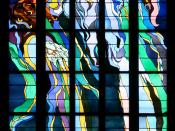Abstract
This paper answers the question of, " What factors led to the rise and decline in stained glass art popularity?" It explains the ways in which the factors that lead up to the rise in popularity for stained glass art are surprisingly also those which caused stained glass popularity to decline. These factors are proven to be aesthetics, education, architecture, religion, social class, and politics. The investigation includes both personal experience through travel and apprenticeships as well as reputable secondhand sources in relation to the popularity of stained glass art in Europe.
The Interpreter's Journey
In order to better understand the focus of any essay, it is helpful to understand the origins for why the question was asked. As the daughter of a professional glass engraver, I have been surrounded by stained glass artists all of my life. Thus, many of the opinions and knowledge from this paper originate from interaction with these individuals and the knowledge in stained glass that I have acquired through my on-going stained-glass apprenticeships with them.
Thus, my experiences have led me to consider the reasons for why stained glass entered its golden age of popularity as well as whether or not those reasons were linked to its ultimate downfall.
The triggers that induced the rise in popularity when they were in effect were related to aesthetics, education, architecture, religion, social class, and politics.
Aesthetic Reasons
Consider the memorable quote which starts the novel Alice and Wonderland:
"Alice was beginning to get very tired of sitting by her sister on the bank, and of having nothing to do: once or twice she had peeped into the book her sister was reading, but it had no pictures or conversations in it, 'and what is the use of a book,' thought Alice 'without pictures or conversation?'"...


